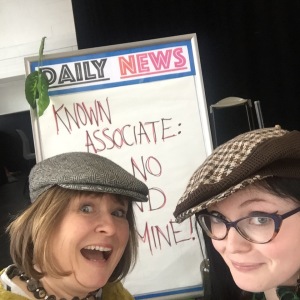 Last week Rachel and I spent a good amount of time doing nothing.
Last week Rachel and I spent a good amount of time doing nothing.
Let me rephrase that.
For three days last week, Rachel and I set off from Glasgow at the crack of dawn heading west. We boarded the ferry to Dunoon in order to get to the secondary school for 8.45am and…er…do nothing. We’d been invited to be part of an Easter project run during Holy Week by a local youth worker and, after much creative brainstorming about the Stations of the Cross, we came up with the idea of setting up a living tableau that would build towards the end of term assembly.
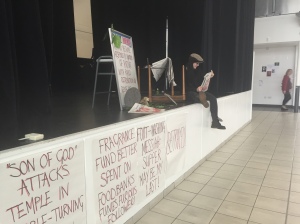
Over nine break times we proceeded to build a newspaper stall with headlines proclaiming the events of the Easter narrative and culminating in the question ‘So what?’. To create our piece of performance art we also added a prop for each headline and took up residence on stage as newspaper sellers. We read the papers, chatted, ate, slept and interacted with any pupils brave enough to approach us.
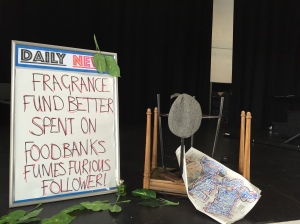 Meanwhile, the level of interest grew. “What are they doing?”, “Why are they just sitting there?” and, most often, “Do they get paid to just sit there?”. Staff encouraged pupils to come and find out for themselves. We attracted a small band of loyal followers who would come over and chat at any opportunity. During one lunch break I was offered a choc ice by an S5 pupil. She said she felt sorry for me just sitting there while everyone around me ate lunch, but later in the day confessed that really she came over because she was utterly intrigued.
Meanwhile, the level of interest grew. “What are they doing?”, “Why are they just sitting there?” and, most often, “Do they get paid to just sit there?”. Staff encouraged pupils to come and find out for themselves. We attracted a small band of loyal followers who would come over and chat at any opportunity. During one lunch break I was offered a choc ice by an S5 pupil. She said she felt sorry for me just sitting there while everyone around me ate lunch, but later in the day confessed that really she came over because she was utterly intrigued.
But most people just walked past and averted their eyes when they realised that we had spotted them looking at us.
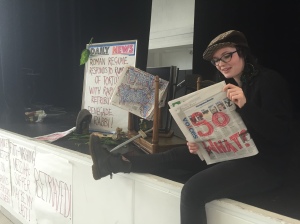 All was revealed at Thursday morning’s assembly when the two newspaper sellers shouted their way through the headlines then relaxed with a creme egg to discuss the ‘So what?’ question. There was more news, they had heard. The man who was so brutally crucified the other day had been seen alive and well – talking, laughing, eating, living. What kind of man was this? One who could break the rules of the universe, and defeat the powers that held him dead. Good news indeed!
All was revealed at Thursday morning’s assembly when the two newspaper sellers shouted their way through the headlines then relaxed with a creme egg to discuss the ‘So what?’ question. There was more news, they had heard. The man who was so brutally crucified the other day had been seen alive and well – talking, laughing, eating, living. What kind of man was this? One who could break the rules of the universe, and defeat the powers that held him dead. Good news indeed!
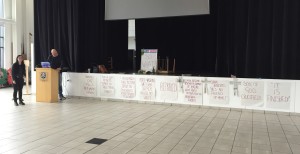 And why am I blogging about this? Obviously, I’m quite pleased that the gamble of doing nothing paid off. The pupils were engaged with the topic. Staff were generally enthusiastic. The head teacher is looking forward to whatever we choose to do next Easter. The local team had great conversations with young people about Jesus. We managed to cross the stormy Clyde six times without losing our breakfast or lunch.
And why am I blogging about this? Obviously, I’m quite pleased that the gamble of doing nothing paid off. The pupils were engaged with the topic. Staff were generally enthusiastic. The head teacher is looking forward to whatever we choose to do next Easter. The local team had great conversations with young people about Jesus. We managed to cross the stormy Clyde six times without losing our breakfast or lunch.
But, as the sign read, so what?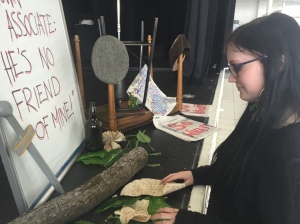
I think there are a few lessons we can learn from our week in Dunoon Grammar.
Firstly, there’s the challenge to those of us who work in schools to value the benefit of working within the parameters of the educational context. Too often over the years I’ve encountered Christians who try to ‘get away’ with as much as they can in schools, shoe-horning a message into anything they’ve been invited to do. I’ve done it myself. Most of the time this is fine, albeit a little rude to the host school and insensitive to the environment, but at times it can verge towards a form of spiritual bullying that tries to force a response from young people who have not chosen to be present. It can also make life very difficult for Christians who work in the school regularly. Learning to serve is even more important in a post-Christian context. Many young people I encounter have very little knowledge of the Bible or understanding of the gospel. While the temptation to pack a message that includes everything I think they ought to know is strong, it takes more imagination and prayerful sensitivity to find ways of working in a wholly appropriate manner within the context of Religious Observance, or a subject-based curriculum.
 Secondly, there’s a challenge to those of us who are artists who follow Jesus, to allow a piece of art to speak for itself. Recently I heard a story told by the Christian visual artist, Bruce Herman, who was asked why he thought that no great artist had come out of the evangelical Christian community. Stuck for an answer, one of his colleagues interrupted him and suggested that, “The imagination doesn’t grow in this soil.”. What a searing indictment of our heritage. Herman’s response to this haunting comment has been to see the fostering of imagination amongst Christian artists as his mandate as a painter and teacher.
Secondly, there’s a challenge to those of us who are artists who follow Jesus, to allow a piece of art to speak for itself. Recently I heard a story told by the Christian visual artist, Bruce Herman, who was asked why he thought that no great artist had come out of the evangelical Christian community. Stuck for an answer, one of his colleagues interrupted him and suggested that, “The imagination doesn’t grow in this soil.”. What a searing indictment of our heritage. Herman’s response to this haunting comment has been to see the fostering of imagination amongst Christian artists as his mandate as a painter and teacher.
I am someone who loves words and action, and as a writer and performer, I have to battle the desire to control the message and people’s response to it. The artist wields the power to evoke response in the audience through manipulation, but often there is greater power in allowing the art to speak for itself. Sitting on a stage doing nothing surrounded by seemingly unconnected props afforded those who observed the chance to form their own responses, ask questions, and ultimately made space for God to speak.
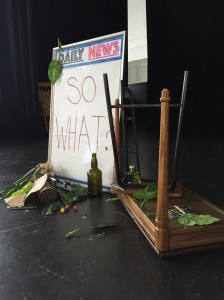 Thirdly, those of us who live in this post-Christian world can take something away from this art. My observation when apparently “reading the paper” was that many people were drawn to look at what was going on simply by virtue of the fact that there was something unexpected and unusual amongst the normal setting of the school hall. By reimagining the story into the ordinary context of daily life we engendered curiosity and interest, finding a hook to the genuine astonishment and pace of the first Holy Week as it would have been experienced by the disciples who lived through the events.
Thirdly, those of us who live in this post-Christian world can take something away from this art. My observation when apparently “reading the paper” was that many people were drawn to look at what was going on simply by virtue of the fact that there was something unexpected and unusual amongst the normal setting of the school hall. By reimagining the story into the ordinary context of daily life we engendered curiosity and interest, finding a hook to the genuine astonishment and pace of the first Holy Week as it would have been experienced by the disciples who lived through the events.
It’s simple to achieve this with a piece of art, but I’m left wondering what it looks like to reimagine this incredible, life-changing, cosmic gospel story in the normal setting of my street, my workplace, my family? The most obvious conclusion to draw is that Christians need to be in the mix to start with. Being a living, breathing, eating, helping, thanking, serving, forgiving, praying ‘work of art’ in the ordinary setting of the place where we live speaks volumes before we open my mouths and speak. And being prayerfully present, and willing to be observed, will prompt the ‘so what’ question from those around us.
